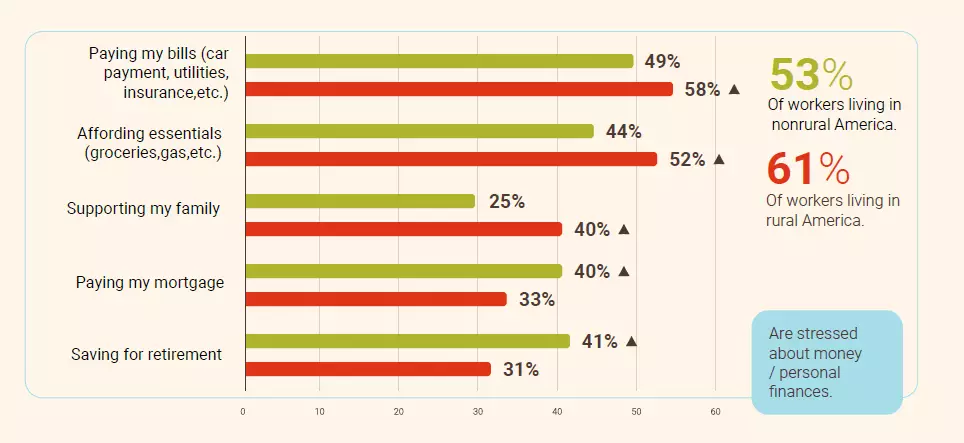The future of work in rural America

Written by Elizabeth Exline

While workforce trends like return-to-office mandates and rage applying
might dominate the headlines, there’s an equally important topic that doesn’t get the same level of attention: the future of work in rural America.
Why is this an issue? Or, more to the point, why should an urban audience concern itself with it? Because, as the G.R.O.W.™ Generating Rural Opportunities in the Workforce™ report reveals, what happens to the rural workforce affects us all.
“It’s time for everyone to start thinking about the country overall and leveraging all our capabilities across the board,” says Raghu Krishnaiah, the chief operating officer at University of Phoenix.
Commissioned by University of Phoenix and the Center on Rural Innovation, the G.R.O.W. report pulls back the curtain on what life and employment are like in rural America. Here, we take a closer look at those challenges, trends and opportunities.
Beyond city limits
Since at least the Industrial Revolution, the narrative about the rural workforce has mentioned exodus. Whether driven by the excitement or economics of a big-city job, young people have migrated out of the countryside for more than a century.
“If you look back at the history of a lot of small towns across the country, you’ll see that they had their highest population levels at the turn of the last century,” says Bill Menner, the founder of the rural-development consulting firm The Bill Menner Group.
That has left rural communities with a dwindling, aging and often less economically robust population who must face certain stressors with fewer resources. Consider these findings from the G.R.O.W. report:
- 58% of rural workers report feeling stressed about paying bills compared with 49% of nonrural workers.
- 52% of rural workers report feeling stressed about paying for essentials like groceries compared with 44% of nonrural workers.
- 40% of rural workers report feeling stressed about supporting their families compared with 25% of nonrural workers.

That stress appears well-founded. “The rural workforce [is] more than twice as likely to rely on assistance for food and utility costs relative to those in nonrural areas,” the G.R.O.W. report states.
No wonder people are hightailing it out of rural communities.
The sheer number of people considering leaving, though, is worrisome. The G.R.O.W. report notes that more than two-thirds of rural Gen Zers and millennials have considered relocating because they view their employment opportunities limited.
“I was surprised 75% are actually thinking of moving out,” Krishnaiah says. “That’s huge. … There isn’t enough housing right now in urban areas. … So where are people going to live? It’s [also] going to [increase] the cost of living even more. … So, you’re going to create more inequity than you have today. That’s a problem.”
Menner, however, is not without hope. Younger workers — no matter where they live — want to leverage opportunities made more available through technology. As he puts it: “If you think about the opportunities that exist through technology, whether it’s educational opportunities that come online, or job opportunities from remote work, that’s something that I think young people are interested in exploring.”
The challenges facing rural communities
Having the will to explore something doesn’t always translate to having the ability. According to the G.R.O.W. report, “The rural workforce continues to feel left behind and under-leveraged, often unable to access the work or education they desire. With fewer business networks, limited technology infrastructure and a dearth of locally available educational resources … the rural-nonrural divide is at risk of widening.”
At least two major obstacles are responsible for that threat.
The issue of access
Roughly 41 million Americans live more than 30 minutes away (by car) from the nearest college or university, according to the G.R.O.W. report.
Online options aren’t exactly a reliable fallback, either. Rural workers report having less access to the tech they need for education (24% of rural workers compared with 9% of nonrural) and less access to broadband (16% rural compared with 7% nonrural).
How is this possible? The federal government allocated $42.45 billion in 2021 to the Broadband Equity, Access and Deployment (BEAD) program. Its express mission was to install broadband in rural and tribal communities as well as underserved communities in all U.S. states and territories.
The result so far? Zero connections.
Another federal initiative, the Affordable Connectivity Program , brought complicated results. Its demise in May 2024 over a lack of funding impacted some 3.4 million rural households that relied on lower-cost broadband services supported by the program, the G.R.O.W.™ report says. (More than 300,000 Native American households were affected, as well.)
The reasons for such inefficiencies may be up for debate — the G.R.O.W. report cites the “complex maze of initiatives across numerous departments and agencies,” for instance — but all is not lost. Overall connections rose three percentage points (or by 13 million users) between 2021 and 2023, according to the National Telecommunications and Information Administration. This suggests communities not only recognize their shortfalls but also band together to innovate solutions independently or with local support.
The issue of quality
Access to the internet and other technology is one thing. The quality of said resources is another. As noted in the G.R.O.W. report:
- 11% of nonrural residents rate the quality of technology as poor, but 36% of rural residents make that assessment.
- 32% of rural workers rate the quality of internet service as poor or fair, while 10% of nonrural workers do.

So, what’s a well-intentioned society to do? Menner, who engages regularly with issues like these, sums it up this way: Millions of Americans don’t have the services they need, which excludes them from opportunities like remote work and upskilling. Solving for that requires more than awareness.
“How do you set aside rural challenges from urban challenges?” he asks. “And convince a majority of members of Congress to vote for that? … It seems that even though there are 20 to 30% of Americans who actually live in small towns, a lot of decisions are made that don’t always reflect what their specific needs are.”
Reimagining the future of work in rural America
With the advent of AI and remote work dominating the culture, there seems to be a renewed imperative to address the factors impacting the future of work in rural America.
“I think University of Phoenix is in a position to do a lot of things,” Krishnaiah says. “We’re very focused on — and always have been focused on — helping people have opportunities where opportunities weren’t there before.”
The G.R.O.W. report supports this outlook, noting that pathways for skill development and career mapping fall within the purview of educational institutions.
Other potential solutions identified in the report are:
- Institutional support for rural communities by increasing their ability and capacity to “navigate the policy systems” and access allocated funds
- Formal and informal mentorship programs, including networking events, facilitated by educational institutions, employers and nonprofit organizations
- Institutional and educational pathways to entrepreneurship, especially with more than 50% of rural workers wanting to own their own business
This vision of a collaborative approach between educational institutions, businesses, government and nonprofit organizations may be what eventually gets rural workers over the finish line in terms of connecting to opportunity.
As Menner notes, that’s a rising tide that benefits everyone. “We in rural economic development, think a lot about the rural-urban connections that exist, and the fact that small towns need their neighboring big cities to survive. … At the same time, there are benefits for those urban areas, having a network of strong, thriving vital places around their periphery … [having] a strong workforce of trained, talented workers who are eager to fill voids that exist in that local workforce. … So there there’s a synergy that needs to exist between rural and urban [areas].”
Looking at it that way, it becomes a “why not” rather than a “why” sort of situation. A stronger workforce offers exponential benefit for everyone: employer and employee, urban and rural communities, small businesses and big corporations.
“Rural workers are no different from folks in the big city,” Menner says. “They just live in a smaller town with maybe a different ZIP code.”
Visit the University of Phoenix Career Institute® to download the full G.R.O.W. report.
G.R.O.W. Generating Rural Opportunities in the Workforce™
The G.R.O.W.™ report uncovers career barriers and opportunities for rural workers, spotlighting disparities between rural and nonrural communities.


ABOUT THE AUTHOR
Elizabeth Exline has been telling stories ever since she won a writing contest in third grade. She's covered design and architecture, travel, lifestyle content and a host of other topics for national, regional, local and brand publications. Additionally, she's worked in content development for Marriott International and manuscript development for a variety of authors.
This article has been vetted by University of Phoenix's editorial advisory committee.
Read more about our editorial process.
Read more articles like this:



